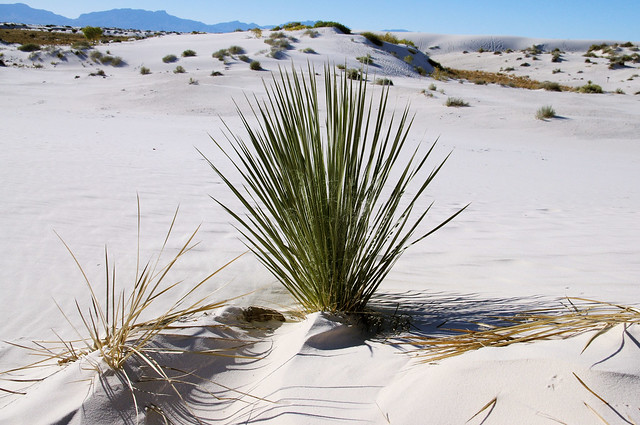
Bright white sand.
Vast blue sky.
Off in the distance, stark mountains.
Starkly beautiful – and deadly at times.
Alkali Flat Trail (National Park Service)
There is no shade or water along the trail, and summer temperatures can exceed 100 degrees F (38 ° C). Heat-related illness is common in warm weather and can be fatal. Hike during cool times. Carry food and at least two quarts of water. Rest, eat and drink when tired. Drinking water is available only at the Visitor Center. The white sand reflects sunlight. Protect all exposed skin from sunburn. Protect your eyes by wearing sunglasses. We recommend that you do not hike alone.
On Tuesday, August 4, a French couple, with their 9-year-old son, set out on an afternoon hike into the searing desert at White Sands National Monument. They started out on the Alkali Flat Trail at about 1 p.m., with two full 20-ounce water bottles. The high temperature for the day was 101°F.
Be Safe in the Desert (White Sands National Monument trailhead sign)
In the desert, temperatures can vary up to 50°F in one day. Always bring an extra layer of clothing to be prepared for changing weather conditions. Take a minimum of one gallon of water per person per day and snacks. Because the sand reflects sunlight, use plenty of sunblock and wear a hat and sunglasses. Talk to a ranger for additional safety information.
About a mile and a half into the hike, the mother, Ornella Steiner, began feeling ill, stumbled, and aggravated a pre-existing knee injury, according to the son, Enzo. She decided to head back to the car, while the others continued on, but she only traveled back a couple hundred yards before collapsing.
Patrolling rangers found Mrs. Steiner’s body. Trying to figure out why she was on the trail alone, the rangers examined her mobile phone. Finding photos on the phone of her son and husband at the park’s entrance, rangers mounted an immediate search. In a little less than an hour, Enzo was discovered alive, but his father, David Steiner had died. The pair were slightly off the trail and had only progressed about a half a mile past the point where Mrs. Steiner turned back.

Both images in this post are from our visit to White Sands National Monument on October 13, 2011. We didn’t take any part of the Alkali Flat Trail as it was quite late in the day by the time we got that far into the park and we had already done a couple of short hikes. Only one of the two, Dune Life Nature Trail, a 1 mile loop trail, actually went out into the dunefield. Even though it was autumn, late in the day, and a short trail, I’m pretty sure we took water.
We have, at times, not taken water with us on a trail when we should have, or not taken enough, but never in extreme conditions like those present on August 4 at White Sands. Usually, our error has been in going further down a trail than we had planned. Most of the time, though, we have more than enough water for the whole hike.
We have found it amazing, at times, when we are out on some of the trails over a mile or two in length and see folks out there who are obviously not prepared. No water or little water. Flip-flops and sandals over terrain that warrants sturdy footwear. Skimpy clothing when it’s glaring hot – or when it’s quite chilly.
The Steiner tragedy at White Sands was preventable. Perhaps some will learn from what happened, but, somehow, I doubt many will.
Bright white sand.
Vast blue sky.
Starkly beautiful – and deadly.
Related articles:
- A French Couple’s Love for the American West Ends in Tragedy (NY Times)
- French couple who died in desert gave son extra water, sheriff said (CNN)
- French couple who died hiking in New Mexico desert likely saved son by giving him their water (Daily Mail)
- First picture of parents who died on desert trek but saved son by giving him extra water (Mirror)
Related blog posts

